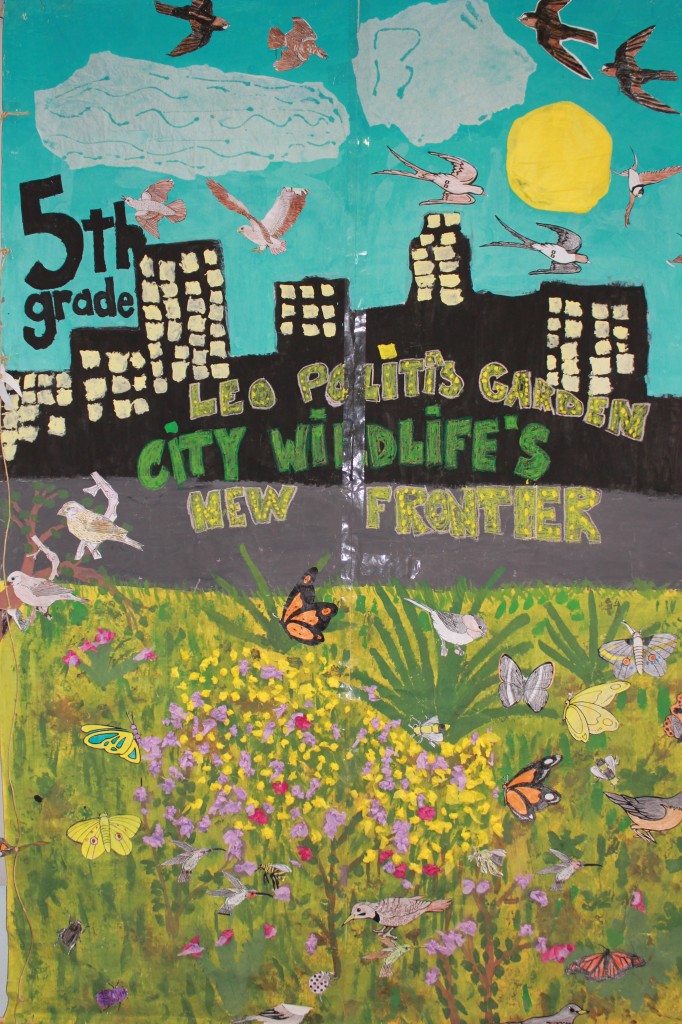Sight and understanding
Posted on | May 28, 2010 | 3 Comments
 In November, 2009, with support from the US Fish and Wildlife Service and Los Angeles Audubon, the students, parents and staff at Leo Politi Elementary School planted a native garden at the Pico Union campus. Last week, botanical studies of the plants drawn and colored by the students went on display in the school auditorium. If they look traced, and I took them for that in an earlier edition of this post, they’re not (please see Margot Griswold’s correction below). Rather, while the display and attitude of the plants in the drawings look like they owe a debt to professional illustrations, the studies by the children were made as part of a class in which the students grew, dissected and studied the plants. Then their eyes were guided along the minute conformations of plants that most of us never see. They were being taught to observe the species, then key them by their tiniest and most telling traits, then to identify their native ranges on a map and relate those traits to climatic and geographical pressures, and finally to differentiate between common and botanical names.
In November, 2009, with support from the US Fish and Wildlife Service and Los Angeles Audubon, the students, parents and staff at Leo Politi Elementary School planted a native garden at the Pico Union campus. Last week, botanical studies of the plants drawn and colored by the students went on display in the school auditorium. If they look traced, and I took them for that in an earlier edition of this post, they’re not (please see Margot Griswold’s correction below). Rather, while the display and attitude of the plants in the drawings look like they owe a debt to professional illustrations, the studies by the children were made as part of a class in which the students grew, dissected and studied the plants. Then their eyes were guided along the minute conformations of plants that most of us never see. They were being taught to observe the species, then key them by their tiniest and most telling traits, then to identify their native ranges on a map and relate those traits to climatic and geographical pressures, and finally to differentiate between common and botanical names.

Isomeris arborea / bladderpod from California's coastal sage community by Cristine Martinez, Grade 3. Click on the bladderpod to see more drawings.
Systematics, Latin, art and geography merged in one lesson.
Click here to see student renderings of elderberries, toyons and bladderpods by third and fifth graders, or here to learn about the Politi project from Los Angeles Audubon.
Note: The drawing above is freeform and wholly original.
Tags: chance of rain > Emily Green > Leo Politi Elementary School > school gardens
Comments
3 Responses to “Sight and understanding”
Leave a Reply



May 28th, 2010 @ 9:08 am
Nothing less than wonderful! Thanks, Emily, for this uplifting post.
May 28th, 2010 @ 11:28 am
Thanks Emily for highlighting the students work! Just to clarify, the students were part of a Scientific Illustration Class taught by Stacey Vigallon. The process involved observation and drawing, with tracing of their own drawing as part of the process. The classes were as follows:
Class 1: Students dissected a flower, learned the anatomy, then drew a diagram of their dissection.
Class 2: Students learned about field sketching and cartography, then went out to the garden to draw a map from life.
Class 3: Students were given several different photo references of various plants in the garden to study, and then created ORIGINAL sketches based on the photos.
Note: No one was allowed to trace the photos, they had to use careful observation and filter the images through their own brains onto the paper. They created these sketches on tracing paper, made their own transfer paper using graphite, and then transferred their original sketch onto high-quality drawing paper (by tracing their drawings). Just like a carbon-copy check or receipt – tracing paper was essential because other art paper is too thick to get the drawing to transfer. After class, several students went out to the garden to find real-life examples of the plants they had been working on.
Class 4: Once their original sketch had been transferred they used pens and colored pencils to complete the botanical illustration.
The turnout of parents and students last Friday night to see the drawings was fantastic. Thanks to Brad Rumble, Mary Loquvam, Stacey Vigallon, and Linda Dowell.
May 28th, 2010 @ 6:57 pm
What a great project…I love the detailed description of the process involved. Hope a lot of other teachers get going with something like this.
Perhaps, Leo Politi School will make a calendar as a fund raiser using these very interesting drawings. In my family we remember Leo Politi as a great illustrator.